LED aquarium lights will likely produce the most plant growth in a planted tank and are one of the best ways to achieve that. However, a comprehensive guide is needed to help with best utilizing them.

For maximum efficiency of the selected grow lights, the beginner should be familiar with the right photosynthesis-inducing spectrum, for example.
Also, if on a budget, will cheap equipment be able to provide that for the money?
If vigorous aquarium plant growth is the goal of your planted tank then which brand of LED lights will work best for you? Is there something else you should know?
The 8 Top-Rated LED Lights for Growing Lush Aquarium Plants

| Light Name: | Planted Aquarium Depth: | Grows: | Price Bracket: |
|---|---|---|---|
| 1. Finnex Planted+ 24/7 ALC | Shallow / Medium / Deep | Medium / High-light Plants | $$$ |
| 2. Fluval Plant 3.0 | Shallow / Medium / Deep | Medium / High-light Plants | $$$$ |
| 3. Current USA Satellite Plus PRO | Medium | Medium-light Plants | $$$$$ |
| 4. NICREW SkyLED Plus | Shallow | Low-light Plants | $ |
| 5. Beamswork DA Pent | Shallow / Medium | Medium / High-light Plants | $$ |
| 6. Finnex StingRay | Shallow | Low-light Plants | $$ |
| 7. Finnex FugeRay Planted+ | Shallow / Medium / Deep | Medium / High-light Plants | $$$ |
| 8. Hygger 24/7 | Shallow | Low-light Plants | $ |
Beginner guide on LED grow lights for planted aquariums
To make an educated choice about my aquarium lighting I would first need to be familiar with how both parties function.
I suggest bookmarking this page for further reference as it’s not a small amount of information. Here’s a complete beginner guide on LED aquarium lighting for aquatic plants:
1. Don’t fall for the Kelvins myth
I often hear (and read) how other fishkeepers determine the effectiveness of their grow light by using Kelvins.
However, this measurement can be quite irrelevant for growing aquarium plants.
You’ve probably heard someone saying that the best Kelvin rating for aquatic vegetation is 6500 K.
Some claim it is even higher, reaching up to 9000 K or above.
This misconception persists because it has been known that the Sun burns at around 6000 K at noon.
Being the main source of light for all outdoor plants alike, some folks have hinted that this Kelvin range might have something to do with plant growth.
In actuality, however, this couldn’t be further away from the truth.
In layman’s terms, the Kelvin rating is the color temperature of light emitted from a light source.
Anything above 5000 K is bluish, and light with a K-rating of below 3000 K becomes yellowish.
The sun burns at nearly 5700 K, but because of our atmosphere, it gives off a white hue at noon.
However, when it comes to LED lighting, the K-rating that manufacturers state has nothing to do with the actual burning temperature.
Why you may ask?
In aquarium lighting the Kelvin ratings are based on a metric called Color Correlated Temperature (CCT).
This means that the human eye will perceive the light color from a 5800 Kelvin LED or fluorescent aquarium lighting as it would perceive the color of sunlight.
However, the fixture won’t literally burn at 5800 Kelvin.
Following these thoughts, here’s how Kelvin ratings impact aquarium plants:
The only real use of Kelvin ratings in aquarium lighting is their perceived color. Lower Kelvin ratings of 3000 and below will give off a yellow hue, medium Kelvin ratings of around 6000 will appear white and higher Kelvin ratings will be blue-ish. The Kelvin value of grow lights does not impact the growth of aquarium plants.
2. PAR readings and their role in growing freshwater plants
The range between 400 and 700 nanometers on the light spectrum chart is called Photosynthetic Active (or Available) Radiation – PAR.
This is all light that can be employed by plants for photosynthesis.
It turns out LED lights are spectacular at mimicking that.
There’s another, dare I say, equally important abbreviation that you might want to be familiar with and that’s PUR.
Photosynthetic Usable (or Utilizable) Radiation, measures the quality of light per application. PUR is unique for each aquatic plant species.
This would mean that, with everything else being equal, a LED lighting fixture with the right diodes can grow freshwater aquarium plants better than one that seems to have the same PAR output.
PUR is good to have, but PAS is where it’s at.
Photosynthetic Action Spectrum (PAS) indicates which wavelengths of light activate photosynthesis in particular.
These are the wavelengths that trigger a response in chlorophyll A and chlorophyll B (which stimulate plant growth).
PAS is considered for plant growth in particular where PUR can be related to plant health as well.
As you might’ve guessed, PAS wavelengths are also unique for each plant.
Luckily for us planted tank enthusiasts, the manufacturers of LED aquarium lighting are aware of the difference and are tweaking the formula with each new model.
The diodes on the best LED lighting fixtures will target more PUR and ideally PAS while keeping the PAR just about enough.
Here’s a video of a somewhat famous aquarist testing the PAR levels of a next-generation LED aquarium light, compared to its previous version.
The new one (Fluval Plant Spectrum 3.0) gives off less PAR than the older model, but in actuality grows freshwater aquarium plants better.
It’s a good practical example of what I’m explaining here.
Though it seems obvious, I think it’s noteworthy that the LED lights we use to grow corals require different spectrum wavelengths than freshwater aquatic plants, but that’s a topic of another article.
This brings me to my next section…
3. Pursuing the best grow light spectrum for your aquatic plants
LED lighting can be an excellent source of light for aquarium plants and provides one of the best growth for them. If the spectrum is right and the intensity – sufficient, LED lights will absolutely grow the plants in your fish tank.
Let me explain this in detail.
The electromagnetic spectrum that falls under the Photosynthetic Active Radiation contains blue, green, white, and red light, as perceived by the human eye.
You can see that in the below image:
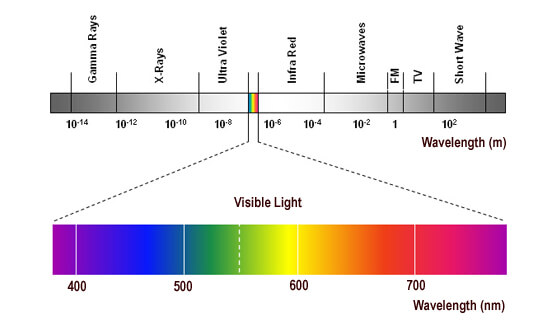
This is why sometimes you can see the “WRGB” or “RGB” label on grow lights. These stand for “white, red, green, and blue”.
Each of these light colors is essential for inducing growth in aquarium plants, with some more than others.
You can see to what efficiency each spectrum wavelength is being used by freshwater plants in the below graph:

What this chart shows is that red light is used the most by plants, followed by blue.
Contrary to popular belief green light is also used, though around 30% is being reflected (hence the green color of most plants).
Because of its lower absorption rate green penetrates the plants’ leaves deeper than the other two colors.
This makes it even more valuable in deep, planted aquariums, where live plants need to make the most of the light’s energy.
Note that it’s efficiency we’re talking about here.
Blue light is high energy particles and for various reasons most of it is somewhat “lost” in the process of photosynthesis.
Note that this graph does not reflect how important the color of the spectrum is for aquarium plants, but rather how well they are able to take advantage of it for their needs.
See a photo of the experiment showing how each plant performed:
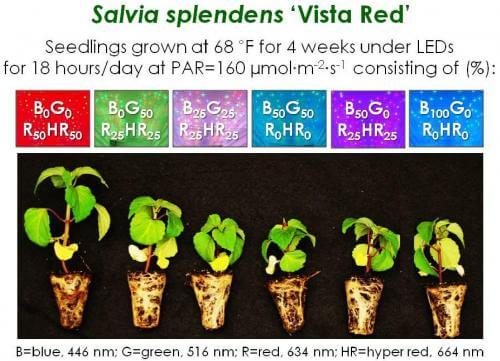
As you can see the most plant growth was achieved by combining 50% Red and 50% Hyper Red light.
Another thing that stands out is that the combination of Red and Green light performed better than anything including over 25% blue light.
However, this is not to say that blue light is not an essential part of photosynthesis.
Blue just needs to be in small quantities in order to not suppress the extension growth of live plants.
- At least 50% red light in the wavelength range of 630 to 700 nanometers
- At least 35% green light in the wavelength range of 500 to 580 nanometers
- No more than 15% blue light in the wavelength range of 435 to 495 nanometers
So…
The perfect spectrum for aquarum plant growth consists of a lot of red, some green, and just a little bit of blue. You can increase the blue for some more stem density, but overall plant mass will be maximized by the red light.
In my recommendations below I’ve taken it into account so you don’t have to.
Okay, let’s add water penetration to the equation.
4. Mind the water penetration of LED lights
Ok, so you know what the right kind of light for a planted tank should be.
For aquatic plants to thrive, however, this light needs to reach its target.
The spectrum changes with water depth.
Here’s an illustration of how wavelengths of light penetrate water:

As you can see our precious red light gets absorbed pretty much on the water’s surface.
However, a planted aquarium will be nowhere near that deep.
That’s a 150-gallon fish tank.
Even at that depth, your aquarium plants will only miss out on around 7% of the incoming red light.
Green light quantities will remain pretty much stable and so will the blue spectrum.
However, as different lighting models have different spectrums, tank depth does play a pretty significant role in your choice of freshwater plants.
I’ve got that sorted out for you in my recommendation section below.
They are all based on my personal experience and observations during work with my clients, where I craft personal gear suggestions for aquarium setups.
So let’s talk about aquarium depth.
5. Tank size & depth matters
There are 2 important aspects of your planted aquarium’s size that affect the efficiency of your LED lights in regard to growing live plants:
- Tank depth (sometimes called height) – this affects water penetration of the spectrum. The lighting fixtures that I recommend will pierce the water excellently, but some will be a better choice than others for certain aquarium height in regards to optimal vegetation growth.
- Tank length – This dimension comes into play when you’re selecting the size of your fixture. There are LED grow lights with extendable brackets and ones without. The brackets only guarantee a good fit and not full light spread and coverage. Some fixtures are limited in size options, so I made sure to recommend whatever will grow your aquatic plants best, while perfectly fitting your tank’s length.
The tank’s width is not that important as the light spread of the fixtures I list below covers 24″ easily. That’s way more than your typical tank width. Only aquarium tanks with a width of over 18 inches and a depth of over 24 inches would benefit from a second lighting fixture.
You can check the numbers of most tanks available today on my resource page for tank dimensions.
6. Being flexible with customization features
Some aquarium-grade LED lights will be more flexible in terms of customization than others.
The manufacturers of the cheaper lights are obviously investing in raw performance, rather than fancy features.
The more inexpensive ones that I recommend will grow aquatic plants just fine as long as you follow my instructions and pointers.
Anyway, the more advanced aquarium LED lighting will allow for better control over the spectrum and on some occasions could even simulate weather patterns.
The weather simulations are more of a gimmick for display purposes. The spectrum customization, however, could play a role in the healthy development of plant mass.
If a timer is being included in the pack then you’ll be enjoying a really nice bonus, because it makes scheduled maintenance pretty much care-free.
7. Keep in mind your freshwater plant selection
Some freshwater aquatic plant species will require more light than others.
There are ones that can be extremely picky of the required intensity and others that will simply thrive under low lighting.
The low-demand ones are usually recommended for beginners, because of their hardiness.
Some aquarium plants that will grow under low levels of light would be:
- Brazilian Pennywort
- Java moss
- Moneywort
- Hornwort
- Guppy grass
- Anubias
- Java Fern (click this link for a beginner-friendly care sheet on that one)
- Vallisneria
…The options are too many to list here.
These are all good options to make for a heavily planted freshwater tank with diverse vegetation.
However, keep in mind that eventually (as we all do after we get hooked) you’ll want to add some more beautiful but demanding aquarium plants.
Here’s a photo of a low-tech aquarium, heavily planted with easy live plants:

Aquatic plants used in the above setup: Pennywort, Anubias, Vesicularia montagnei (Christmas Moss), Blyxa Japonica, Crypt Wendtii, Ceratopteris thalictroides (water sprite).
And here’s a photo of a high-tech tank, planted with demanding aquarium plants, including Baby Tears:
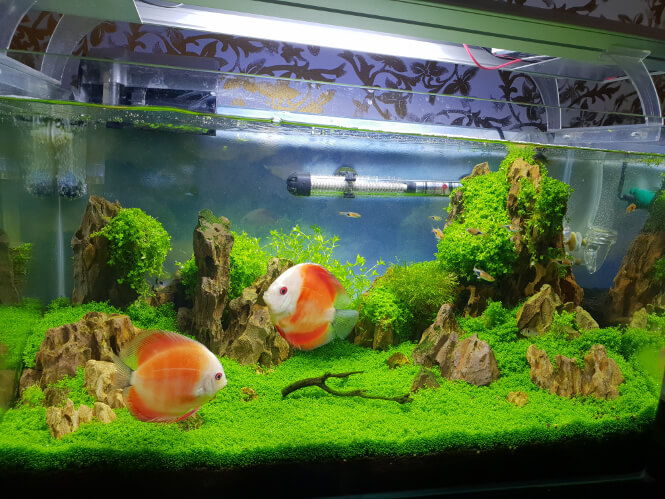
Getting more advanced aquarium lighting will guarantee you excellent plant growth. You’ll be comfortable in adding high-light plants later without considering a new purchase to fit your needs.
A dedicated planted tank aquarist will inevitably want to grow lush carpeting aquarium plants such as the Dwarf Hairgrass or Baby Tears.
Carpeting plants just look so good in an aquarium!
However, with these, you’d want a stronger lighting fixture.
Anyway, with my gear suggestions below I will be covering all possible setups.
I will explicitly mention which fixture suits your plans best, to save you time on further research.
Author’s note: You should also know that the lights I’m recommending here are also suitable for growing saltwater plants in planted marine tanks. The plants that can thrive in saltwater aquariums are usually species of macroalgae, which benefit from the red and full light spectrum.
It’s no wonder refugium lighting puts such a heavy emphasis on the same spectrum.
8. Be aware of lensing and avoid “beam lighting”
Modern LED aquarium lights use lenses in order to concentrate the beam of the diode more.
This gives more PAR and water penetration, which is good for more demanding aquatic plants, such as the carpeting ones.
Though light-emitting diodes penetrate water fantastically anyway, the top LED lighting fixtures, designed to support aquarium plants, usually come with 60º lenses.
This will give off light at a 60º angle per a single diode.
To compare, a Light Emitting Diode (LED) without a lens will give off light at a 120º angle.
As you can see this enhances performance in terms of water penetration and it may further stimulate developing plant mass in the species that are located in the outer parameter of your planted aquarium.
You’ll see where the beam ends and if your grow light does not fit your fish tank’s length perfectly there will be shadowing in the corners.
Removing some of the outer lenses will eliminate this problem.
The process of doing so is absolutely simple even if you’ve never held a screwdriver.
Here’s a short video on how to do it.
Again, this may or may not be needed, and only in the cases where your fixture does not fit your fish tank perfectly.
I made sure to recommend LED grow lights that will best fit in each tank size, but I felt like it was worth mentioning anyway.
The Best LED grow light for vigorous aquarium plant growth: My Reviews
It has been proven that LED grow lights stimulate photosynthesis rates to an extent that makes them the best artificial source of light for a planted aquarium.
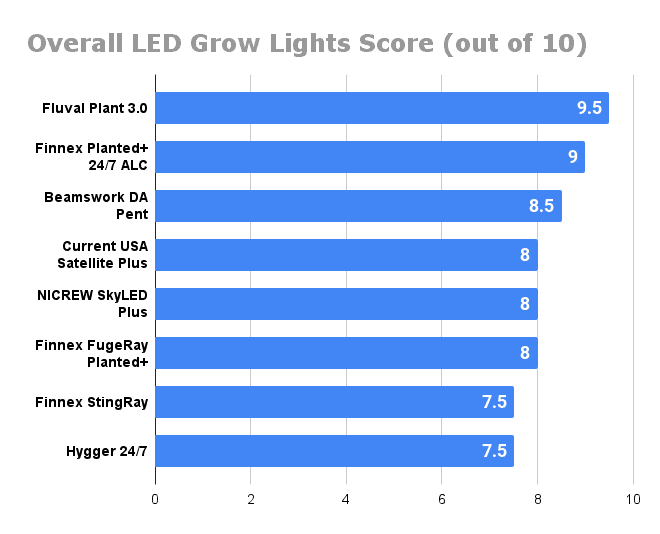
Below you’ll only find reviews of models that I’ve personally used or ones for which I have at least a couple of real-life success examples from my customers or friends.
Check out the best LED lights for explosive aquarium plant growth:
1. Finnex Planted+ 24/7 ALC – Overall Best LED for a Planted Aquarium
Before we start discussing the pros and cons of what’s probably the best LED light for an aquarium with plants, I need to make a few clarifications.
There are quite a few models of Finnex 24/7:
- CRV
- HLC
- ALC
- KLC
- CC
- SE
Although the difference is just three letters in the name, these lights can be very different from one another.
They can all grow plants excellently, but some models are better than others.
In my personal experience the Finnex Planted+ 24/7 CRV has the best spectrum and my plants have responded to it the most. I’ve used it over a standard 55-gallon tank with great success.
However, for a deeper tank, I would use the ALC version which has roughly 50% more PAR than the CRV while still harboring the Deep Red light diodes.
More PAR is useful in deeper high-tech tanks with carpeting plants (21 to 24 inches of depth).
The PAR data comparison can be found directly on the Finnex website.
You could also find additional PAR data specifically for the ALC version on the light’s Amazon listing.
Anyway, purchasing the Finnex Planted+ 24/7 ALC LED is probably the best thing you could do for your high-tech planted tank.
The engineers behind this grow light conducted actual scientific research to make sure the Finnex fixtures utilize the most efficient spectrum for photosynthesis.
My experience with it confirms their findings, at dare I say, 100%.
Turns out this model of LED lighting will grow pretty much anything in a medium-to-deep planted freshwater aquarium.
It has no issues growing demanding carpet plants or some pretentious but cool-looking red aquatic plants.
If you’re familiar with the aquatic flora you already know that, basically, red plant species require the most light to grow well and colorful.
Anyhow, the deepest tank I’ve put my Planted+ 24/7 CRV on was 21 inches, which equals the standard height of a 55, 75, and 125-gallon tank.
However, I’ve used and recommended the ALC version to many aquarists with deeper tanks and have seen great results.
Anyway, aside from their potential to support vigorous plant growth, these LED lights come with a full pack of customizable features. They are accompanied by a handy remote control, which gives you control over different weather patterns, including the 24/7 mode.
The latter will simulate a 24-hour cycle of lighting, mimicking outdoor conditions.
Though beautiful these are more of a display gimmick, so you could just put it on a timer if you want.
Anyway, the feature you could take serious advantage of is the customizable spectrum, where you’re given complete freedom.
Author’s note: CO2 injections are recommended alongside this fixture because its potent light-emitting diodes can otherwise induce algae.
I encourage you to go for the purchase only if you’re planning a medium to a high-tech planted tank.
The Planted Plus ALC fixture is physically durable and the only part I’m not really satisfied with is the plastic mounting brackets.
Finnex could probably improve this but the somewhat brittle brackets do the job of holding the unit in its place.
The brackets allow you to mount the lighting body on a brace or a rimless aquarium.
Another inconvenience I would like to mention is the overall shorter cord. No idea why it’s this short.
Good for entry-level hobbyists but also used by experienced fishkeepers (me included), the Finnex Planted+ 24/7 LED light is top-notch when it comes to aquarium plants.
I recommend it.
Advantages:- Intense with an excellent spectrum for plant growth
- Will grow virtually every aquarium plant there is
- Outstanding performance in medium-deep tanks (15 to 24 inches of aquarium depth)
- Fantastic pricing for the value you get
- Deeply customizable
- The 24/7 mode is a care-free way to look after your aquatic plants
- Brackets are designed to fit on both a rimless tank and on the ones with a brace
- The cord could be longer (it’s not super-short, but it’s not a convenient length either)
The Fluval Plant 3.0 is, in my observation, rivaling the Finnex Planted+ 24/7 in terms of performance.
I own these LED lighting fixtures personally but I also have a very close friend of mine who runs it on 2 of his display tanks.
He’s basically a guru at planted tanks and also my teacher, so to speak.
In an attempt to give you guys a piece of valuable advice I’ve consulted with him for this review.
Anyway, I can see that the live plants in his fish tank setups with the Fluval Pant Spectrum 3.0 are flourishing with growth.
This is a LED light for medium or high-requiring freshwater vegetation.
Pressurized Carbon Dioxide is recommended by definition on planted tanks that run this unit or you’ll find yourself in an algae situation.
I’ve seen the Fluval Plant 3.0 crush it on anything with 21 inches of depth, which are basically your 55 and 75-gallon standard tanks.
In terms of customization, I could say that these LEDs are slightly better than the Finnex one above.
Here, on top of everything else, you get pre-setting modes that include a “Planted Tank” mode. If you want to squeeze the maximum potential of the customization, you could ramp up the white and red and lower the blue wavelengths.
The pre-set mode will absolutely grow your aquatic plants though.
Aside from that, the body of the Fluval Plant Spectrum 3.0 LED is rather lightweight and has a sleek design.
It also has something that not many manufacturers can brag about – a waterproof rating of IP67.
A rating of IP76 basically means that water evaporation from your aquarium won’t harm this LED light, which extends the expected life of the fixture significantly.
This may be the reason why the manufacturers offer a 3-year warranty.
No other aquarium lighting can beat that.
Author’s note: – The Fluval Plant Spectrum 3.0 LED is, in fact, more durable than the Finnex Planted+ 24/7, from my observations.
Another pro I think is worth mentioning is that the lenses of this fixture allow for 120 degrees of illumination, completely eliminating the beam-light effect. No shady corners in your planted aquarium whatsoever.
Anyhow, an issue I would like to point out with the Fluval Plant 3.0 is the App, which controls the light customization.
This LED light is relatively new to the market and the App needs some polishing.
From time to time there may be connectivity issues, which completely removes your control over the lighting in your tank.
Another thing is that if there’s a power outage the light will get stuck on blue until you come home and reset the settings from your mobile phone. Too long of this and algae may sprout (though we’re talking days, here).
Nevertheless, the Fluval Plant Spectrum 3.0 is an overall great LED light for freshwater planted aquariums that aim at keeping thriving live plants.
It is somewhat new to the world of planted tanks, but it’s already risen to the top.
If you have the budget and the right setup in mind – go for it.
Advantages:- Grows pretty much any aquatic plant
- Efficient for medium-deep aquariums
- Has pre-set grow modes that work for aquatic plants
- Detailed customization available
- The lightweight sleek body design
- Waterproof certified (IP67)
- 120º lensing for maximum spread of the beam
- 3-Year Warranty and is very durable overall
- After a power outage, you have to reset the settings from the room where the aquarium is
- May seem pricey, though that’s normal for a premium product of this class
- The app. Even though it’s been so long since it came out, the app still is somewhat weird to navigate and not as user-friendly as I’d like it to be at this price point.
3. Current USA Satellite Plus PRO – Ideal for stem Plants in Medium-Deep Tanks
Click to compare pricing + see MORE photos of this product at:
My experience shows that in a tank with a decent depth such as the 55-gallon and the 75-gallon ones, which are both 21 inches deep, the Current USA Satellite+ PRO could absolutely look after your medium-light plants.
That type of vegetation I’m referring to basically includes stem aquarium plants and, sometimes, an easy-to-grow carpeting plant.
The spread of light is decent and it covers the whole planted tank well.
This LED fixture does not provide sufficient lighting for demanding red plants or at least not enough to stimulate explosive growth rates (red plants, for example).
Following these thoughts, I would run the grow light over my medium-depth fish tanks that are very heavily planted but do not contain super difficult aquatic plants.
This way I’d take advantage of the Satellite+ PRO’s potential to the fullest.
Aside from plant growth, this LED grow light is the perfect addition to a display planted tank.
Why? Because it has tonnes of fancy features.
The Current USA Satellite+ PRO is programmable to simulate all kinds of weather patterns, including thunderstorms or passing clouds.
The timer that comes with it is better than your usual one, as it remembers the settings even after a power outage.
The only thing that you need to keep in mind is that you have to manually turn it on after the power comes back.
The Satellite Plus PRO lighting fixture also comes with a remote which, at least to me, is pointless because it only works on a very close range.
Do make sure you run this LED light over a glass top because the body is not waterproof and water evaporation from your planted aquarium may damage it.
I’d purchase this product, if I wanted to have a beautiful, heavily planted 55 or 75-gallon tank, that would not contain difficult live plants.
Just a quick note that if you’re going to shop anything Current USA, then Chewy.com is your friend.
They always have it on some kind of discount, it’s never out of stock and, often, the prices will beat even those at Amazon.
Advantages:- Supports the growth of medium-light stem plants fantastically
- Has a beautiful natural spectrum
- Spectacular show-off modes
- Blue LED diodes do not induce algae
- The timer is better than most
- More expensive
- Not waterproof (run it over a glass aquarium hood)
- The remote control does not work over long distances
4. NICREW SkyLED Plus Lights – Perfect for Tanks with Below-Medium Depth on a Budget
The NICREW SkyLED Plus is the type of light I would be skeptical to get at first.
Although it’s extremely popular among fishkeepers, to a beginner it may appear too inexpensive to actually grow plants.
Fortunately, along with the next entry (the Beamswork Pent), the NICREW SkyLED Plus has managed to stay afloat as one of the best budget lights for a planted tank.
I’ve seen this light grow low-to-medium demanding plants pretty well in tanks that are between 12 inches and 18 inches deep. In fact, the SkyLED Plus would even cause some algae issues if the tank is 12 inches deep and the fixture works at 100% power.
To avoid unwanted algae in such shallow tanks, which is basically the 10-gallon Leader, I recommend stuffing your aquarium with plants to the brink.
From my observation, covering all of the substrate with plants ensures that the algae won’t outcompete them.
Anyhow, the NICREW SkyLED Plus can also be used in an 18-inch deep tank with success if you’re growing low-light plants with a couple of medium ones here and there. An example of a standard tank with this depth would be the 29-gallon one.
Anyway, the spectral light channels themselves are dimmable, which is a fantastic feature to have at the price point of this LED light.
The blue “night” mode looks cool but is overall useless when it comes to plant growth.
However, the “daylight” mode is incredibly bright and it also includes diodes that provide red light in the 660 nm wavelength range.
I’m assuming the latter is why the NICREW SkyLED Plus performs so well with aquatic plants, given its price.
The full spectrum mode also makes the more vibrant fish really pop with color.
Author’s note: The brightness of the SkyLED Plus LED lights may shock you at first. Some users even report tuning the intensity down, just because it seems too bright.
To me, the brightness levels of this light are not surprising as it reportedly has the most PAR out of all the other NICREW models.
Anyhow, the SkyLED is also built from aluminum whereas the first generation of NICREW lights was built from plastic, with the exception of the longest fixtures.
And finally, a con I would like to mention about this aquarium light is that it does get warm to the touch.
I would not consider it dangerous, but it can raise the aquarium’s water temperature by a degree, so keep that in mind.
Advantages:- Budget-friendly
- Can grow low AND medium-light plants
- Way more durable than the previous models
- Brightness that makes your tank pop with color
- Slick design
- Extendable brackets which helps it fit on more unconventional tanks
- Gets noticeably warm
- Brackets can sometimes seem loose
5. Beamswork DA FSPEC 0.50W Pent – Brighter Than You Might Expect
The Beamswork DA FSPEC 0.50W Pent is a slightly upgraded version of the Beamswork EA FSPEC.
A slight upgrade, however, does not mean a slight difference in performance.
Author’s note: I’ve used both of the DA and EA models when I was building my tanks on a tight budget and I was pleasantly surprised with the results.
The EA FSPEC is more than enough for a low-tech planted aquarium setup in a shallow (up to 12″ deep) tank. The EA version will support the basic low-light plants known in the hobby.
Anyway, the Pent will ultimately work for a 10 Long, 15, 20, or 30-gallon breeder planted tank that’s high-tech in nature. Again, tanks with 12″ of height.
However, at this depth you should make sure the tank’s bottom is covered with plants and that you have a CO2 system in place. Otherwise, you risk getting hair algae to bloom or making the water green, which can be annoying to treat afterward.
The risk of algae bloom is because the Beamswork Pent really is intense. In fact, it is one of the most intense LED lights you can get on a budget.
Following these thoughts, you could use it on deeper planted tanks too.
I even sometimes recommend lining 2 Pent LED fixtures next to each other to light up planted aquariums with 24 inches of depth. However, that’s only in the case where the tank is 72 inches long and the aquarist wants 6-foot long LED fixtures to match the length.
Anyhow, the Beamswork Pent LED light will support the growth of aquarium plants that require a lot of light, which, given its price, is more than welcome.
The Pent’s spectrum is not as optimized as Finnex and Fluval’s, but you can still get a good amount of plant growth.
Speaking of which, the Beamswork Pent LED light is on the inexpensive side because you don’t get any additional features.
You don’t even get a timer. You should, however, get the separate timer/dimmer Beamswork offers which you can see here.
Without a dimmer, you still risk inducing algae in shallow tanks.
Anyhow, the daylight spectrum brings out colors of fish and aquarium plants alike nicely, giving your planted tank a really attractive tint.
The cons here would be that the Light Emitting Diodes do not provide a perfect blending of the beam and if the water surface gets too excited by your filter or aerator you might notice a slightly disco-colored bottom.
To avoid that I recommend that you get these light fixtures if the substrate in your aquarium is a darker color.
If your plans for a planted aquascape fit in this description then get either model and call it a day.
I give the Beamswork LEDs thumbs up.
Advantages:- Very competitive pricing
- A sleek and simplistic design
- Will grow medium to high-light plants in shallow to medium-deep setups
- Spectrum makes the colors of aquatic plants and fish pop
- No extra features whatsoever
- A timer / dimmer should be bought separately (use the one Beamswork offer themselves – it’s worth it)
- If the substrate is a light color then you might notice the disco-effect of beams not blending too well (just go with a darker substrate, such as Black Diamond Blasting Sand which looks good in a planted tank anyway)
6. Finnex StingRay – Perfect for a 5-gallon low-tech tank
As the title goes this LED light will serve smaller planted aquariums pretty well.
If you plan to have a small, 5-gallon tank that’s planted and also has a couple of nano fish, or a Betta in it then the Finnex StingRay may be your best bet in terms of lighting.
Low-light aquatic plants will thrive under it as Finnex made sure the spectrum is in the sweet spot of wavelengths for photosynthesis.
Though the illumination isn’t enough for more demanding greenery the Kelvins are at 7000, which is great for the overall colorful look of the tank and fish in it.
You won’t be getting any fancy customization, by the way – just an ON and OFF switch.
If you are planning on such a setup, you’ll be satisfied with the growth of your aquarium plants and also with the durability of the fixture. Finnex is known to make long-lasting equipment in the freshwater aquarium lighting industry.
The cons of this unit are the usual suspects – the plastic mounting brackets and the shorter cord.
Both of these can be somewhat annoying but they won’t really impact how the live plants respond to the spectrum of these LED lights.
Get this light if you’re having a small, planted tank that’s low-maintenance and has a Betta or some other nano fish in it.
Advantages:- Beautiful daylight spectrum that makes your aquarium plants pop out
- Grows low-maintenance plants in shallow aquariums (no more than 10 inches deep)
- Simple and sturdy build
- No customization
- Mounting brackets are somewhat flimsy
- The cord is shorter than with your usual aquarium lights
7. Finnex FugeRay Planted Plus – Grows Difficult Plants in Medium to Deep Tanks
The Finnex FugeRay Planted+ is a super bright aquarium light that grows high-demanding live plants.
I’ve personally used it on my 30-gallon tank with standard height to grow an underwater carpet.
FugeRay did not have any problems with making my red plants flourishing either.
That’s a depth of 12 inches.
However, this fixture is good for aquarium lighting on any high-tech planted tank that has no more than 48 inches of length.
This may be so because the diodes of the FugeRay are heavily leaning towards the red wavelength of the spectrum.
As we know the red light with 660 nanometers of wavelength is where it’s at for plant growth.
Frankly, the Finnex FugeRay Planted+ is really the best light I can think of for tanks with greenery that demands raw power.
As for the cons, there are not many.
A major one would be that the build is not IP67 waterproof certified, which means you’d have to position the fixture over a glass lid.
Obviously, this will extend the expected life of the product.
Another thing is that the light does get a little warmer than your usual LED lighting but it’s not actually hot or anything, so there’s that.
It has a night mode, but I would recommend avoiding that as the blue light could induce algae in your planted aquarium.
Though you probably figured that out, I think it’s also worth mentioning that you should use CO2 in such a setup, to further reduce the chance of algal spores developing.
And finally, the FugeRay Planted Plus doesn’t have a dimmer and I haven’t found a good one for it.
This can be a big con because if you discover that the grow light induces algae in your tank, you’d want to either:
- raise it;
- return it;
- introduce more plants to the tank.
Author’s note: Essentially the FugeRay Planted+ packs a slightly stronger punch than the 24/7 ALC in terms of intensity.
However, price-wise they are almost equal but the ALC has different modes and way more controllability.
Following these thoughts, I would get the FugeRay Planted+ if I wanted to run a tank with very high-demand aquatic plants.
It also makes sense to use this LED light on very deep tanks such as the standard 90-gallon one.
Advantages:- Spectrum leans on the red (660 nanometers) which is excellent for high-demanding aquarium plants
- Powerful output
- Gives a very eye-pleasing pink-ish tint to a planted aquarium
- Is fantastic for high-tech setups
- Lightweight and thin body
- Not dimmable
- Short cord
- Plastic brackets
- Rarely it may start flickering (Use a Q-tip with 99% alcohol to clean the circuit board if that happens – it’s a one-time fix and you’re good to go)
8. Hygger 24/7 – Good customization in a budget light
So the Hygger 24/7 can be a good alternative to the other budget aquarium LED lights such as the NICREW SkyLED.
On that not the SkyLED will grow aquarium plants slightly better.
What I liked about the Hygger 24/7 when I tested it on my own fish tank was its customizability.
At its price point you can’t beat that.
My aquatic plants responded well to it and I started seeing results almost immediately (read “a week”).
The previous light on this tank was a a basic one from an all-in-one kit.
Another thing I think makes this budget LED light stand out is that it’s made with waterproof gluing.
This shields the lighting diodes from water vapor coming from your fish tank which extends the live of the fixture.
Author’s note: I’m trying to be careful with my wording about the waterproof thing because the Hygger 24/7 doesn’t have an official IP rating, as is the case with Fluval’s Plant Spectrum 3.0.
Anyway, so far so good.
Seemingly the Hygger 24/7 rivals the premium LED lights on this list with its customization options while being a fraction of the cost.
So where’s the catch, Momchil?
Well, the 24/7 feature is not well programmed – the light starts to dim too early in my opinion. This makes the timer kind of useless, which can be a deal breaker to people who like a more hands-off approach.
In itself the timer is pretty basic and limiting though if it were programmed better it would’ve been very useful.
Also, although this did not happen to my Hygger 24/7, there seem to be some dud batches that break around the 1-year mark.
Mine works fine to this day, far surpassing the 1-year mark.
So if you’re up to getting the Hygger 24/7 consider that there’s a small chance yours is from the dud batches.
Advantages:
- Great price point
- Excellent plant growth for low-light plants
- Great for shallow aquariums
- Pre-set 24/7 mode simulating the natural daylight cycle
- Diodes are sealed with a waterproof material, protecting the fixture from fish tank evaporation
- Timer is basic and not programmed too well (it can still do its job, depending on your setup)
- There’s a chance you get a dud batch which seem to last around a year.
Which LED lights should work best according to your planted aquarium’s gallon capacity and depth?
I’ve motivated and explained in detail each of my size-related recommendations in my general guide on LED aquarium lighting. You can click this link to check it out. Right at the top of the guide, you’ll find a table containing each tank size. Find yours and click on that to see why I’m suggesting this precise model for this setup and aquarium dimensions.
That being said, the best LED lighting according to your planted aquarium’s gallon capacity and depth would be:
- 5-gallon tank with low-demand plants: Finnex Stingray
- 5-gallon tank with high-demand plants: Finnex Fugeray Planted Plus
- 10-gallon tank with low-demand plants: Beamswork EA FSPEC
- 10-gallon tank with high-demand plants: Finnex Fugeray Planted Plus
- 20-gallon LONG tank with low-demand plants: NICREW SkyLED Plus
- 20-gallon LONG tank with high-demand plants: Beamswork DA FSPEC 0.50W Pent
- 20-gallon HIGH tank with low-demand plants: Beamswork EA FSPEC
- 20-gallon HIGH tank with high-demand plants: Finnex Planted+ 24/7 CRV
- 30-gallon tank with low-demand plants: Beamswork EA FSPEC
- 30-gallon tank with high-demand plants: Beamswork DA FSPEC 0.50W Pent
- 40-gallon tank with low-demand plants: NICREW SkyLED Plus
- 40-gallon tank with high-demand plants: Finnex Planted+ 24/7 CRV
- 55-gallon tank with low-demand plants: Current USA Satellite+ PRO
- 55-gallon tank with high-demand plants: Finnex Planted+ 24/7 ALC/CRV OR Fluval Plant Spectrum 3.0
- 75-gallon tank with low-demand plants: Current USA Satellite+ PRO
- 75-gallon tank with high-demand plants: 2x Finnex Planted+ 24/7 ALC OR Fluval Plant Spectrum 3.0
- 90-gallon tank with low-demand plants: 2x Beamswork DA FSPEC 0.50W Pent
- 90-gallon tank with high-demand plants: 2x Finnex FugeRay Planted Plus OR 2x Finnex Planted+ 24/7 ALC OR 2x Fluval Plant Spectrum 3.0
- 125-gallon tank with low-demand plants: Current USA Satellite+ PRO
- 125-gallon tank with high-demand plants: Finnex Planted+ 24/7 ALC/CRV OR Fluval Plant Spectrum 3.0 OR 2x Beamswork DA FSPEC 0.50W Pent
Though I’ve mentioned the answers here, I also have a separate guide on choosing lighting for a 125-gallon planted aquarium, because not many manufacturers offer a 72-inch long fixture and fitting can be a nuisance.
Should you go for the more cheap LED lights if you’re on a budget?
Mind that all the LEDs I am listing here are on the inexpensive side, given the industry’s tendency to overprice equipment.
You could absolutely find aquarium lighting that goes up to $400 and it will grow live aquarium plants just as well.
However, the models I reviewed above can all be considered budget-friendly and you’ll be getting the best bang for your buck if you decide on them.
As I said these grow lights have proved themselves to me and others countless times already, just make sure to get the right one for your planned plant setup.
That being said, going for a cheaper LED light for your planted aquarium, should not necessarily mean low quality, but, say, limited customization and only sufficing for a setup with low-maintenance plants.
You could say that the fixtures in my guide are the best performing aquarium lights for the money.
For how many hours a day should I leave the LED grow lights on?
The main indicator your plants are not getting enough light is slow or no growth at all. In general, some leaf discoloration may also occur but these are mainly caused by nutrient deficiencies in the plant.
Here’s a general lighting schedule for your aquarium plants:
Typically, most freshwater aquarium plants will thrive on 8 hours of full aquarium lighting.
If you leave the grow lights on for between 8 and 10 hours, there will be an abundance of light that may be further employed by algal spores.
Author’s note: Leaving on any actinic light during the night, also known as “night mode” may also induce algae because the blue and ultraviolet spectrum are utilized by most algae species.
If green hair algae or, perhaps, Black algae start appearing in your planted aquarium – reduce the daily lighting schedule to 6 hours which should be enough for your live plants, but will suffocate the algal growth.
Additional tricks to further boost the growth rate of your aquarium plants
Having the right aquarium lighting is just 50% of the equation.
You should be able to recognize what’s the best aquarium fertilizer for your aquatic plants if you want to achieve a contest-worthy planted tank. I have a guide on those over here.
I made it very beginner-friendly and you’ll almost immediately discover the right aquarium fertilizer for your setup. Visit the link and have a quick skim over it.
Anyway, the basics of it are that the fertilizers go in either the water column when in liquid form or in the substrate when they come as root tablets.
Speaking of substrates, there are ones that are specially designed to grow aquarium plants. If supplementing macronutrients with fertilizers is not your thing you likely need a good substrate for 100% healthy and thriving growth.
However, some of these substrates will be expensive, yet won’t contain the key nutrients advertised on the bag.
To sort out the good from the bad ones and to help you understand the whole nature of substrates for aquarium plants I’ve created this beginner guide.
Give it a skim and you’ll learn how to distinguish quality from phony advertising.
And before we finish – do your research on a good CO2 regulator so that your planted aquarium could benefit from a stable and precise dosing of Carbon Dioxide.
FAQs
What is the best one for optimal plant growth?
The best LED light for plant growth is the one that is powerful enough to send light in the right spectrum right to the bottom of your tank.
For freshwater aquatic plants, the best spectrum is usually the red and green one, according to the scientific research. Red penetrates water the least, so it’s important that your LED aquarium light sports dedicated red diodes.
What color should one emit for aquarium plants?
Generally speaking aquarium plants grow best under a combination of red, green and blue light. White light is a combination of those so it also works well, depending on the spectrum proportions.
The most important light color for plant growth is red. Also, a tiny portion of blue will stimulate stem and leaf fullness. Too much blue light will likely result in an algae outbreak in the aquarium.
Will 5000K ones grow aquarium plants?
5000K is what is known as “natural white” light. White light can be a combination of different proportions of red, blue and green light.
Since Kelvins are only used to measure what color the light appears to the human eye, they are not a good way to assess quality of light for plant growth.
That being said, if your 5000K LED light has a decent amount of red and green in its spectrum then it will probably grow aquarium plants well.
Which one is the best for preventing unwanted algae growth?
Algae sprouts in aquariums that receive too much light that is not being used by the plants in the tank. Algae spores start employing the unused incoming light and use it to grow.
One way to control algae outbreaks in your aquarium is by reducing the intensity of your LED light. Another way to decrease the incoming light is to move the tank away from sunlight from a nearby window.
Finally, planting more plants in your aquarium will result in less available light for algae to use. Heavily planted tanks rarely have algae issues.
Over to you
After finishing this article you should be confident and knowledgeable enough to make an educated choice.
Explosive plant growth will come as long as you follow the instructions and pick the best LED grow lights for your setup.
I wish there was someone who’d sit and tell me all the things I had to learn the hard way throughout the years.
If you’re still unsure or have a custom planted aquarium, tell me in the comments and I’ll do my best to offer you a piece of advice.
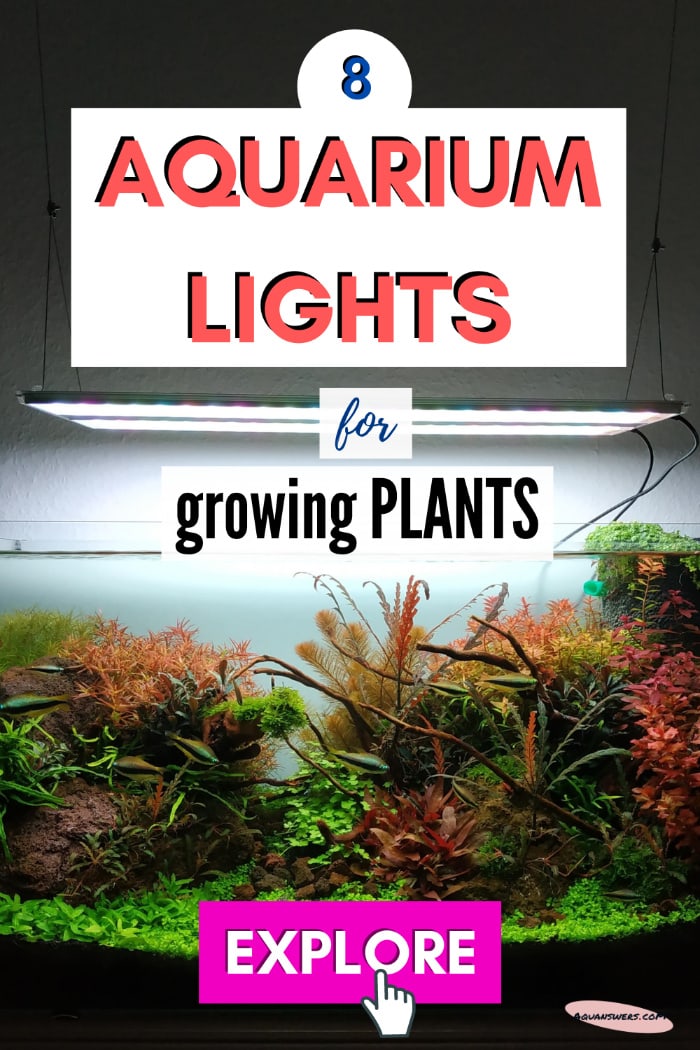

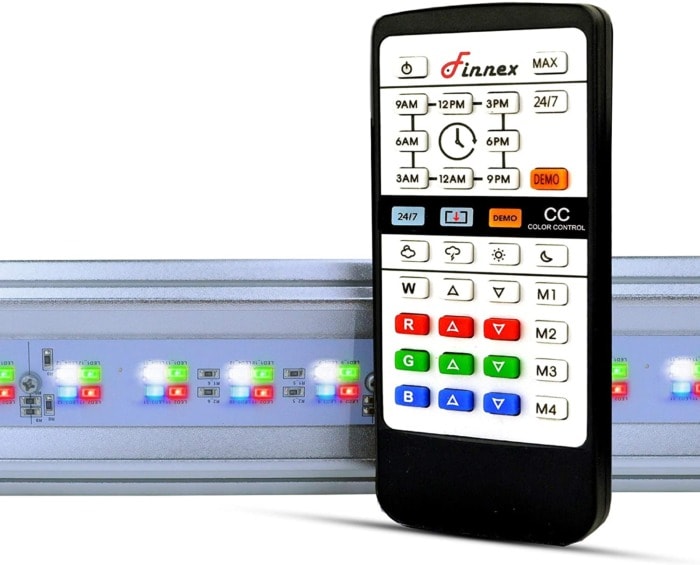


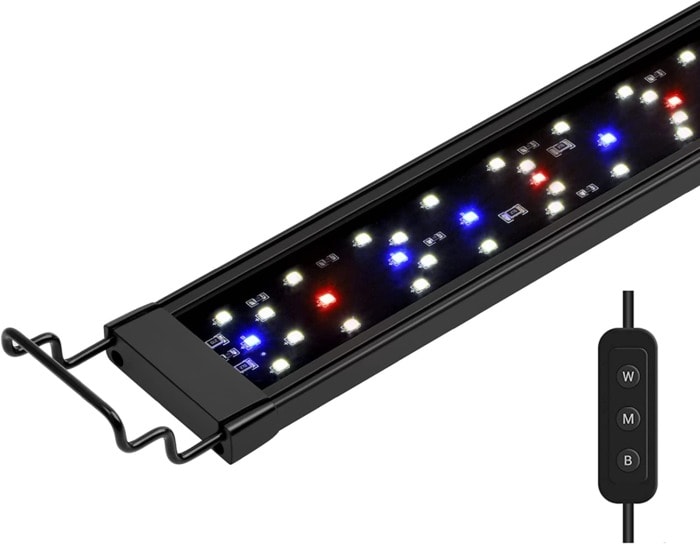


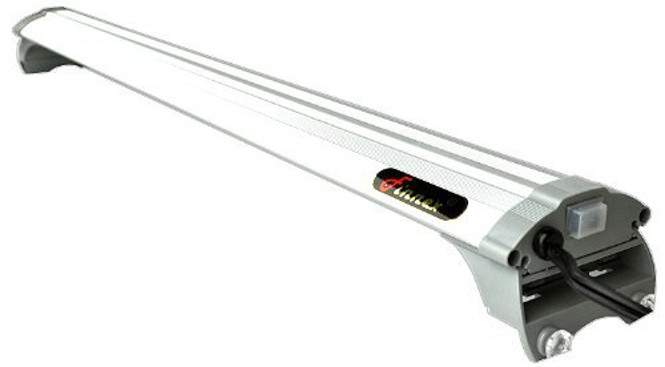




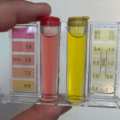



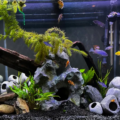
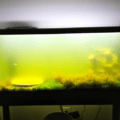
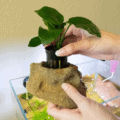
this is the first article i found that provided actual numbers. thank you so much dude! i’m trying to build my own light and this helps a great deal.
Glad I could be of help, Tina!
Stay well :I
Thank you too for the warm feedback, Tina 🙂
Hello to all my friends. I am a guide. After several years of studying and researching aquarium plants, I have been able to calculate the light appropriate to their growth very accurately, along with the required wavelengths. And now I want to rate it exclusively to Let me have a company that can build it. If anyone knows of a company, please let me know.
Editted: don’t leave personal information
Hi
Title: Low growth of aquarium plants
As you know, different companies have produced different types of plant growth lamps, but access to the exact values of the different wavelengths used to grow and color plants is a top secret, and only for a small number of Companies are available.
After years of research and study in the biology of aquarium plants, I was able to calculate the appropriate optical system for the growth of this species of plant, which has the lowest risk of algae, using valid scientific charts.
To assure you, I can send you a sample calculation and construction instructions for a proposed hypothetical aquarium. If you are satisfied, I will give you the unique score “How calculations, graphs and wavelengths affect photosynthesis”.
Hi,
I’m curious as to if your findings contradict what Michigan State University found on the subject. Could you share some info here, in the comment section?
Thanks in advance!
Hello,
I have Nano-Cube 28g and I have simple basic plants. This aquarium comes with some intense LED lights that are made for salt water, but I’m using this for fresh water. I’m able to control the intensity of the light through an app on my phone to change blue, white and red levels as a percentage. Would you happen to know the levels I should set each individual color for my application? There is no green light and when I read the article I didn’t see a percentage for white light (unless I missed it). Thanks!
HI, the green spectrum is almost half of white light along with some red (at least in LED diodes). You can, in your case, treat it as a combo of 50:50 green/red. For what it’s worth, tune the red and white up (max) and put the blue at 10 to 15%.
Hope this helps.
I was about to purchase the Finnex KLC 24/7 model for my 29 gal tank (19″ tank depth). However, Amazon’s chart says only the Finnex CRV and Finnex Plant models have True 660nm Red LEDs. Isn’t that important and shouldn’t I buy one of those models instead?
Also, do the remotes allow you to shut the lights off completely? The tank is in my son’s bedroom so it’s important that there is no light at night.
Thanks for your information!!!
Hi Lenore,
Thank you for your inquiry.
Onto your first question:
First, let me just kick this off by saying that ANY Finnex 24/7 model will do a fantastic job at supporting live aquatic plants.
The presence of the True 660nm Red diode is more of a marketing gimmick in my experience. All Finnex 24/7 fixtures incorporate a healthy amount of red (in the right spectrum interval), green and white (the latter being a mixture of wavelengths with a predominance of green) spectrum, sufficient for vigorous plant growth. I’ve seen quite a few heavily planted tanks that thrive under the KLC. The CRV is slightly more expensive, and it does have a separate red diode, however, from what I’ve seen, the difference in the end results is negligible. My point here is that if you want to do a “top of the top” purchase you can go for the CRV but the law of diminishing return will come at play. For the record, the HLC also has separate red diodes, but the company doesn’t market it as an advantage. You can literally buy any 24/7 and have a stunning planted tank.
Onto your second question:
I am pretty sure that the light does not completely shut off if it’s on the 24/7 setting. You can turn that off and set it manually if you want it to completely go out during the night. I should probably note that the night mode of the 24/7 mode is very very dim, but it may interfere with sleep if you’re a light sleeper (no pun intended) and the tank is right next to your face, for example. So yes, definitely possible to set it up like how you want it for your son.
Ask away if there’s anything else please. I’d be happy to help. 🙂
Thank you! It was confusing because the KLC doesn’t mention the spectrum of red but the CRV did, so…. I will buy whichever has the better reviews for the price!
You mention the need for CO and substrate fertilizers — do you have an article explaining these? We moved our tank to my son’s room a few months ago and it’s in a dark corner. It’s seems we’re battling brown and green algae alternately, and as of yesterday, at the same time! Never a dull moment, LOL!
Hi,
Yeah, I linked to both guides under the “Additional tricks to further boost the growth rate of your plants” section. As for the algae issues and this is a shot in the dark but… add more live plants and check that the water you use for water changes does not contain too much nitrates!
Good luck
Hi, I recently bought a Fluval Plant 3.0. The led colours don’t include green. Pink, blue, cold white, pure white, and warm white. Is this providing the proper spectrum?
Hi, Tara,
Thank you for your question.
Yes, absolutely. The Plant 3.0 is a very capable fixture in growing aquatic plants and is one of my personal favorites.
If you look at the spectrum diagram, Green is basically in the middle. White LED diodes contain a decent “amount” of green because white is actually a mixture of all colors. I actually have visual representations for that in my other article on growing chaetomorpha. Type “chaetomorpha” in the search bar and when in the article look up the Quick Navigation table on top and click on the “best spectrum to grow Chaetomorpha”. There’s a good explanation about green and its role in the making of white in LED diodes.
Long story short The Fluval Plant 3.0 provides a very adequate spectrum for growing plants.
Good luck.
what is it that green is doing for the plant?
Hi, that’s a really good question!
Green seems to still be employed for photosynthetic processes although not as effectively.
I don’t know what are the specific benefits of green light for the way plants develop, though.
Hi love the info on this site
Have a 100gal reefer Aquarium with Radion lights
The problem I’m having is that I’m getting to much light I think as I’m getting brown algae growing on all my plants. Right now my red and green are 100% blue and RedBlue are at 40% Uv at 50% and white 100%. I also add co2 which has stimulated plant growth nicely.
Hi Richard!
What’s your specific model and Generation of the Radion? You can tune down the blue and UV to about 20% by the way.
Anyway, since it’s a planted tank I’m assuming your nitrates are below 10 to 15 ppm?
It could be that you’re getting silicate or silicic acid in the aquarium from your tap water or (possibly) the choice of a sandy substrate.
Both high nitrates and silicates could induce brown algae.
Also, what’s the depth of your tank?
I don’t think the problem is too much light, to be honest. If it’s lighting that’s causing the diatoms it would be too little light.
What you can do is put in some silicate absorbing media, manage nitrates if needed and physically clean the substrate and your plants.
To be honest I haven’t measured the nitrates lately and actually will be doing that next, my main problem is I am so busy that at times I’m not paying enough attention. But oddly enough my other aquarium which is a lot simpler I have hardly any issues and all the plants are growing nicely, but in my Reefer 450 3 door with sump 59” L x19-3/4” W x 22 H, with Radion XR15w FW Pro Generation 4 LED light
In the sump pit I have 4 blocks 8x8x4 MarinePure which is designed to be a substrate for bio-filtration, specifically to target ammonia and nitrite removal.
I also have a reverse osmosis water system to fill the water in the aquarium as it evaporates so no hard water
The substrate is CaribSea Eco-Complete and there’s about a 2-1/2 layer
Along with a Aqua Medic CO2 Reactor external mounted and a CarbonDoser Electronic Co2 Regulator I can control the size of bubble and speed digitally where by I keep the ph at 6.6 and 6.7 the aquarium temp sits at 80F
Hope this gives you some more info and what I’m striving for is a natural underwater garden, don’t mind mowing or trimming the plants
HI again,
The tank is not really deep by fish keeping standards, and the lighting seems solid, probably hitting 120+ PAR at the bottom.
Sorry if I did not understand correctly, but you only top off the aquarium water with RO/DI? DO you use remineralized RO/DI for water changes? Water changes will gradually remove silicates and nitrates from the water.
Anyway, there’s a recent trend where Eco-Complete leaches silicates (not silica, silica is inert) in the aquarium causing diatom outbreaks.
Silicate removers are also an option but they will require recharging now and then.
I’m assuming the tank is relatively new, correct? The diatoms will use up what they feed on in the water (usually silicates) and will eventually go away on their own. This often happens in new fish tanks. Eventually, you will have a natural underwater garden…
Hope this helps to a degree.
Regards
Thanks for the info, tank is 2 years old and I’m just using Straight RO water for water changes and top ups
Hi,
there must have been something you changed before the diatoms appeared. I am running out of ideas, I was rather confident it was the substrate…
Part of the cost of these lights is that they are waterproof. Lights intended for growing plants indoors are less expensive and have the same wavelengths as recommended here. I bought these:
Link.
They are not waterproof so I mounted them behind the tank facing towards the plants. Much cheaper!
Hi Ron,
thanks for your input. This is true, but it depends on what you want, durability, customization, spread of the light, PAR etc. The ones you listed are okay for a single house plant, but in my opinion lack on most of these, though the PUR is probably right.
Just my two cents.
Happy aquarium keeping!
The spectral percentages you give are Red 50%, Green 35% and Blue 15%, however the customizable led’s have a White channel as well. Do you recommend setting that at 100%?
Hi Stephan,
These are not spectral percentages but rather a physical diode ratio.
If you’re talking light channel settings then these percentages should translate to… ramping up the red to 100%, the green to 70% and blue to 30% for maximum efficiency.
About white light intensity: Since it is a combination of the other three colors white light will always be beneficial for aquarium plant growth. Having it at 100% will maximize the specific PUS needs of different species of plants by a slight margin (be it a little more red, slightly more green, etc.).
This is not to say that pure white LEDs will do great for a planted tank as you don’t have control over the proportions used in emitting that white light.
Hope this clears things and it helps!
Drop me another comment if you have more questions.
Hi,
I have just restarted my tank with LED and CO2 and would like my Monte Carlo plant to do well, it’s on the bottom. I have red 100%, green 70% and blue 50% from 12:00 until 19:00. I am adding ferts once a week. Do you think I am overdoing it? There’s a lot more plants as well but I do really want the bottom to be all green. It’s on ADA Amazonia soil btw.
Hello,
I would only tune down the blues to about 15% to 20% depending on what visually appeals to me the most. Other than that I think it’s reasonable.
Good job on the ferts and the soil. I don’t see why this wouldn’t work.
Hope this helps.
Thanks for the reply, I’ve made the change to blue. Will see what it’s going to do!
so, how many percent red, green, blue, and white if i want make LED HPL 36 Watt and every led 1 watt? my tank deep 40 cm and height 60 cm.
Hi,
White light is made through the combination of red, blue and green and it mostly plays a role in pleasing the human eye.
It is beneficial for growth, but you don’t have control over the proportions of red, blue and green in it.
At your tank depth, you can add up 2-3 white light diodes and keep the percentage proportion for red, blue and green for the rest.
This could be played out as 17 red diodes, 11 green ones, 5 blue ones, and 3 white ones (rough estimations).
Hope this helps!
Fantastic article! For a beginner like me, tank depth is something that’s hard to find information on. Gallons is a poor benchmark because the shape can differ. I’ve been contemplating a Fluval Plant LED for a 24″ deep tank I’m looking to setup, but I want to keep it low-medium lighting plants (I can barely find time to mow my lawn outside, I don’t want to manage an out of control garden in the house too!)
Hi Marc,
Thank you for sharing your thoughts! To be honest, I haven’t seen anyone else talking about tank depth as well and since dimensions can vary I still have no idea why I’m the only one writing about that.
Anyway, with that depth, you should be able to pull it off, in my opinion. The Finnex 24/7 would also do the trick. If you want more stem plants that require medium lighting you’d probably have to step up your game with the fertilizers (either in the form of a planted tank-friendly substrate or dosing the water column).
CO2 is never redundant in these kinds of deep setups.
Note that you could definitely build a heavily planted tank with low-maintenance (and light requiring) plants with these two fixtures.
Hope this helps!